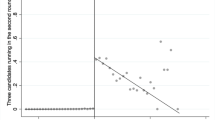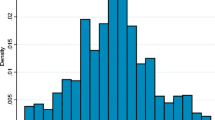Abstract
This paper estimates the incumbency effects using a large dataset on state legislative elections in India during 1975–2003. I use a Regression Discontinuity Design (RDD) that estimates the causal effect of incumbency by comparing candidates in closely fought elections. I find that there is a significant disadvantage to incumbency in Indian State legislative elections, and the adverse effect of incumbency has increased after 1991. Also, the incumbency disadvantage is higher in states that have lower availability of public goods such as health centers, and lower employment, poverty and per capita income.
Similar content being viewed by others
References
Ansolabehere, S., Snyder, J., & Stewart, C. (2000). Old voters, new voters, and the personal vote: using redistricting to measure the incumbency advantage. American Journal of Political Science, 44(1), 17–34.
Bardhan, P. (2001). Sharing the spoils: group equity, development, and democracy. In A. Kohli (Ed.), The success of India’s democracy (pp. 226–241). Cambridge: Cambridge University Press.
Bardhan, P., & Mookherjee, D. (2000). Capture and governance at local and national levels. American Economic Review, 90(2), 135–139.
Bardhan, P., & Mookherjee, D. (2005). Decentralizing antipoverty program delivery in developing countries. Journal of Public Economics, 89(4), 675–704.
Bardhan, P., & Mookherjee, D. (2006). Corruption and decentralization of infrastructure delivery in developing countries. Economic Journal, 116(508), 101–127.
Baron, D. (1989). Service-induced campaign contributions and the electoral equilibrium. Quarterly Journal of Economics, 104(1), 45–72.
Bernhardt, D., & Ingbermen, D. (1985). Candidate reputations and the ‘incumbency effect’. Journal of Public Economics, 27, 47–67.
Butler, D., Lahiri, A., & Roy, P. (1995). India decides: elections 1952–1995. New Delhi: Books and Things.
Chhibber, P., & Kollman, K. (2004). The formation of national party systems: federalism and party competition in Britain, Canada, India, and the US. Princeton: Princeton University Press.
Chhibber, P., & Nooruddin, I. (2004). Do party systems count? The number of parties and government performance in the Indian state. Comparative Political Studies, 41(8), 152–187.
Chhibber, P., Shastri, S., & Sisson, R. (2004). Federal arrangements and the provision of public goods in India. Asian Survey, 44(3), 339–352.
Cover, A. D. (1977). One good term deserves another: the advantage of incumbency in congressional elections. American Journal of Political Science, 21(3), 523–541.
Cover, A. D., & Mayhew, D. R. (1977). Congressional dynamics and the decline of competitive congressional elections. In L.C. Dodd, & B.I. Oppenheimer (Eds.) Congress reconsidered (pp. 54–72). New York: Praeger.
Cox, G. W., & Katz, J. N. (1996). Why did the incumbency advantage in U.S. House elections grow? American Journal of Political Science, 40(2), 478–497.
Cox, G. W., & Morgenstern, S. (1993). The increasing advantage in the US States. Legislative Studies Quarterly, 18(4), 495–511.
Crook, R., & Manor, J. (1998). Democracy and decentralization in South Asia and West Africa. Cambridge: Cambridge University Press.
Erikson, R. S. (1971). The advantage of incumbency in congressional elections. Polity, 3, 395–405.
Erikson, R. S. (1972). Malapportionment, gerrymandering, and part fortunes in Congressional elections. American Political Science Review, 66(4), 1234–1255.
Ferejohn, J. A. (1977). On the decline of competition in Congressional elections. American Political Science Review, 71(1), 166–176.
Fiorina, M. P. (1977). The case of vanishing marginals: The bureaucracy did it. American Political Science Review, 71(1), 177–181.
Fraenkel, J. (2004). Electoral engineering in Papua New Guinea; lessons from Fiji and elsewhere. Pacific Economic Bulletin, 19(1), 122–133.
Fraenkel, J. (2006). The impact of RAMSI on the 2006 elections in Solomon Islands. Political Science, 58(2), 63–85.
Gelman, A., & King, G. (1990). Estimating incumbency advantage without bias. American Journal of Political Science, 34(4), 1142–1164.
Hahn, J., Todd, P., & Van Der Klaauw, W. (2001). Identification and estimation of treatment effects with a Regression-discontinuity design. Econometrica, 69(1), 201–209.
Jacobson, G. C. (1985). Money and votes reconsidered: Congressional elections. 1972–1982, Public Choice, 47(1), 7–62.
Jacobson, G. C. (1987). The marginals never vanished: incumbency and competition in elections to the U.S. House of Representatives. American Journal of Political Science, 31(1), 126–141.
Katz, J., & King, G. (1999). A statistical model for multiparty electoral data. American Political Science Review, 93(1), 15–32.
Laakso, M., & Taagepera, R. (1979). Effective number of parties: A measure with application to West Europe. Comparative Political Studies, 12(1), 3–27.
Lee, D. (2008). Randomized experiments from non-random selection in U.S. House elections. Journal of Econometrics, 142(2), 675–697.
Lee, D., Moretti, E., & Butler, M. (2004). Do voters affect or elect policies? Evidence from the U.S. House. Quarterly Journal of Economics, 119(3), 807–859.
Levitt, S. D., & Wolfram, C. D. (1997). Decomposing the sources of incumbency advantage in the U.S. House. Legislative Studies Quarterly, 22(1), 45–60.
Mayhew, D. R. (1974). Congressional elections: the case of vanishing marginals. Polity, 6, 295–315.
Mitra, S. K., & Singh, V. B. (1999). Democracy and social change in India: a cross-sectional analysis of the national electorate. Sage: New Delhi.
Molina, J. (2001). The electoral effect of underdevelopment: government turnover and its causes in Latin-American. Caribbean and industrialized Countries, Electoral Studies, 20(3), 427–446.
Porter, J. (2002). Asymptotic bias and optimal convergence rates for semi-parametric kernel estimators in the regression discontinuity model. HIER discussion paper # 1989.
Steeves, J. S. (1996). Unbounded politics in the Solomon Islands: leadership and party alignments. Pacific Studies, 19(1), 115–138.
Thistlethwaite, D. L., & Campbell, D. T. (1960). Regression discontinuity analysis: an alternative to the ex post facto experiment. Journal of Educational Psychology, 51, 309–317.
Trease, H. V. (2005). The operation of the single non-transferable vote system in Vanuatu. Comparative and Commonwealth Studies, 43(3), 296–332.
Tufte, E. R. (1973). The relationship between seats and votes in two-party systems. American Political Science Review, 67(2), 540–554.
Uppal, Y. (2007). Estimating incumbency effects in the U.S. state legislatures: a quasi-experimental study. Unpublished manuscript, University of California, Irvine.
Weiner, M. (2001). The struggle for equality: caste in Indian politics. In A. Kohli (Ed.), The Success of India’s Democracy (pp. 193–240). Cambridge: Cambridge University Press.
Yadav, Y. (2000). Understanding the second democratic upsurge: trends of Bahujan participation in electoral politics in the 1990s. In F. R. Frankel, Z. Hasan, R. Bhargava, & B. Arora (Eds.), Transforming India: social and political dynamics of democracy (pp. 120–145). New Delhi: Oxford University Press.
Author information
Authors and Affiliations
Corresponding author
Rights and permissions
About this article
Cite this article
Uppal, Y. The disadvantaged incumbents: estimating incumbency effects in Indian state legislatures. Public Choice 138, 9–27 (2009). https://doi.org/10.1007/s11127-008-9336-4
Received:
Accepted:
Published:
Issue Date:
DOI: https://doi.org/10.1007/s11127-008-9336-4




